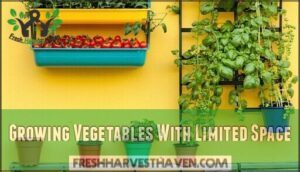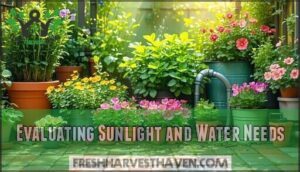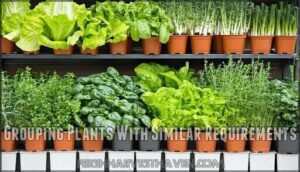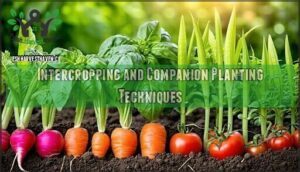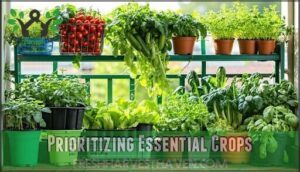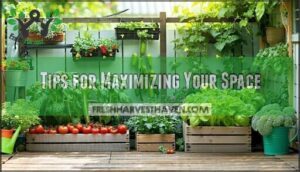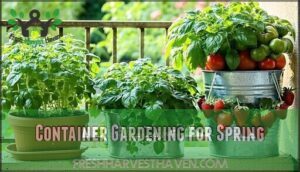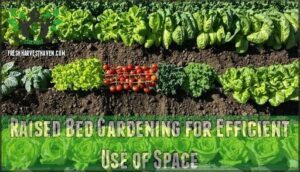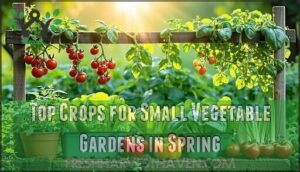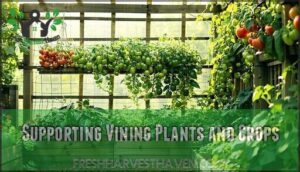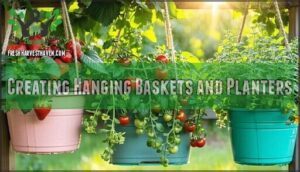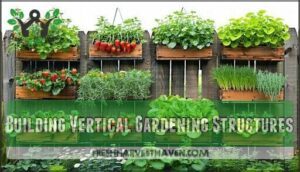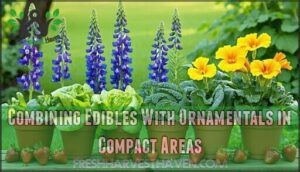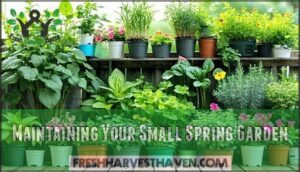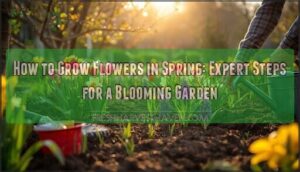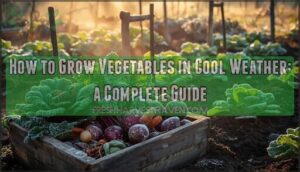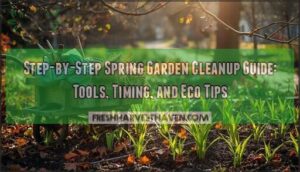This site is supported by our readers. We may earn a commission, at no cost to you, if you purchase through links.
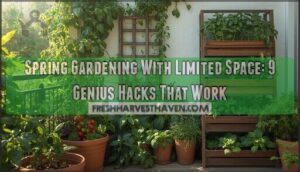
Container gardening gives you complete control over soil quality, while vertical systems triple your growing area without claiming floor space. Fast-growing crops like lettuce provide multiple harvests, and green onions regrow from scraps in just two weeks.
The secret lies in maximizing every square inch through strategic planning and space-efficient growing methods.
Table Of Contents
- Key Takeaways
- Spring Gardening in Small Spaces
- Growing Vegetables With Limited Space
- Planning a Space-Saving Garden Layout
- Tips for Maximizing Your Space
- Container Gardening for Spring
- Raised Bed Gardening for Efficient Use of Space
- Top Crops for Small Vegetable Gardens in Spring
- Utilizing Vertical Space With Trellises and Hanging Baskets
- Combining Edibles With Ornamentals in Compact Areas
- Maintaining Your Small Spring Garden
- Frequently Asked Questions (FAQs)
- How to start a garden with limited space?
- What is the rule of 3 in gardening?
- What is the most common mistake of first time gardeners?
- Which vegetables should not be planted next to each other?
- Can you grow a garden in a small space?
- How to grow a vegetable garden in limited space?
- What are the different types of small space gardens?
- How do I start a small space garden?
- Does limited space limit your gardening dreams?
- What can you do with a small space garden?
- Conclusion
Key Takeaways
- You’ll maximize harvests by using vertical gardening techniques like trellises and stacked containers, which can triple your growing area without claiming additional floor space.
- Container gardening gives you complete control over soil quality and drainage while allowing you to grow fresh vegetables and herbs in spaces as small as balconies or windowsills.
- Fast-growing crops like lettuce, radishes, and herbs provide multiple harvests through succession planting every two weeks, keeping your limited space continuously productive.
- Compact varieties of tomatoes, peppers, and leafy greens are specifically bred for small spaces and deliver full-sized flavors while thriving in containers as small as six inches wide.
Spring Gardening in Small Spaces
You don’t need acres of land to grow fresh vegetables and herbs this spring. Small spaces like balconies, patios, and even windowsills can produce impressive harvests when you use the right techniques and plant varieties.
Gardening in Urban Areas
Urban gardening transforms concrete jungles into productive green spaces. You can grow fresh food anywhere with smart planning and creativity. City environments present unique challenges, but they also offer surprising opportunities for spring gardening and small space gardening solutions.
Urban soil health requires careful attention since city conditions often create contaminated or compacted ground. Container gardening bypasses these issues entirely, giving you complete control over growing conditions.
Here are five proven urban gardening methods:
- Balcony gardening creates thriving ecosystems with herbs and vegetables in containers
- Rooftop gardens get the most out of unused overhead space for food production
- Community gardens offer shared plots where neighbors collaborate on growing projects
- Vertical farming systems turn building walls into living food production areas
- Container gardening provides flexible, portable growing solutions for any urban space
Maximizing Limited Space
Small spaces pack big potential when you think beyond ground-level plots. Container Gardening transforms any corner into productive growing space, while Vertical Gardening doubles your harvest area without expanding your footprint.
Your Limited Space becomes manageable with smart Container Choices—think stackable planters and wall-mounted systems that climb upward. Compact Varieties of tomatoes, peppers, and herbs thrive in containers as small as six inches wide.
Succession Planting keeps harvests rolling by sowing new seeds every two weeks. Quality Soil Amendments like compost boost nutrient density in containers where every inch counts.
Small Space Gardening strategies that work:
- Use reflective surfaces to bounce light into shadowy corners
- Stack containers vertically to multiply growing area
- Group plants by water needs for efficient maintenance
- Install drip irrigation systems for consistent watering
- Choose fast-growing crops like lettuce for quick returns
Spring Gardening success comes from working smarter. Maximizing Limited Space means every container fulfills a purpose, every vertical inch produces food, and every square foot yields maximum harvest.
Growing Vegetables With Limited Space
You can grow fresh vegetables in even the smallest spaces by choosing compact varieties and using vertical growing techniques. Cherry tomatoes, dwarf peppers, and leafy greens like spinach thrive in containers, while trellises and hanging baskets expand your growing area without taking up floor space.
Compact Varieties and Fast-Growing Crops
Choosing the right plants makes all the difference when you’re working with limited space. Compact varieties like ‘Sweetheart of the Patio’ cherry tomatoes and ‘Sweet Golden Baby Belle’ peppers deliver full-sized flavor in containers. These dwarf varieties are bred specifically for small space gardening.
Fast-growing crops keep your harvest flowing. French breakfast radishes mature in just 18 days, while quick harvests of arugula and baby lettuce appear in under 30 days. Green onions regrow from kitchen scraps in two weeks.
Master succession planting by sowing lettuce every two weeks for continuous salads. Container crops like ‘Tom Thumb’ lettuce heads reach just 4-5 inches, perfect for single-serve portions.
For herb selection, choose ‘Piccolino’ basil and dwarf Greek oregano in 4-inch pots. These maximize yields per square inch, making spring gardening productive even in tight spaces. Vertical gardening is also an excellent way to get the most out of space usage.
Utilizing Vertical Space
Compact varieties set the foundation, but vertical gardening techniques tap into your space’s true potential. Vertical gardening systems transform bare walls into productive living walls that triple your harvest without claiming extra floor space.
Pallet gardens and stacked planters turn forgotten vertical surfaces into thriving food sources. Green screens create privacy while producing fresh herbs and vegetables. Hanging gardens get the most from overhead space for cascading crops like strawberries and trailing tomatoes.
Vertical garden design strategies that work:
- Install stacked planters on sturdy fences for maximum growing layers
- Create pallet gardens using recycled wood for herbs and compact vegetables
- Build living walls with modular systems that catch best sunlight
These vertical gardening approaches let climbing plants like peas and beans reach their natural upward growth patterns while you reclaim wasted wall space in your limited space garden.
Growing in Containers and Hanging Baskets
Containers and hanging baskets transform any corner into productive spring gardening space. Container materials like ceramic or plastic work best, while basket selection should include drainage holes. Your soil composition needs quality potting mix with compost for nutrients.
Watering techniques require daily checks since containers dry quickly. Hanging location should get 6-8 hours sunlight. These container gardening methods make small space gardening achievable anywhere.
| Container Type | Best Plants |
|---|---|
| Deep pots (12+ inches) | Tomatoes, peppers |
| Shallow containers | Lettuce, herbs |
| Hanging baskets | Cherry tomatoes, strawberries |
| Window boxes | Radishes, spinach |
| Large planters | Bush beans, carrots |
Planning a Space-Saving Garden Layout
You’ll get the most from your harvest when you map out plant placement based on sunlight exposure and water requirements. Group plants with similar needs together, then use companion planting techniques to fit more crops in less space while improving soil health.
Evaluating Sunlight and Water Needs
Why settle for guesswork when proper sunlight assessment can make or break your spring gardening success? Start by tracking light patterns across your limited space for three days, noting which areas receive full sun (6-8 hours) versus partial shade. This microclimate analysis reveals where to place sun-loving tomatoes versus shade-tolerant lettuce.
Watering schedules depend on your setup—container gardening requires daily monitoring since pots dry faster than ground soil. Check soil moisture by inserting your finger two inches deep. Dry? Time to water. Urban gardening often means managing heat reflection from buildings, creating warmer microclimates that increase water needs.
Consider your water source accessibility when designing layouts. Hand watering works fine for small small space gardening setups, but drip systems save time and water. Match plant placement to both light requirements and irrigation convenience for maximum efficiency.
Grouping Plants With Similar Requirements
Strategic plant grouping transforms your limited space into an organized, thriving ecosystem. You’ll create efficient neighborhoods where plants share similar watering needs, sunlight requirements, and soil preferences.
Start by clustering plants with matching growth habits. Heavy feeders like tomatoes and peppers work well together, while shallow-rooted herbs form their own productive community. This grouping prevents nutrient competition and optimizes your container gardening setup.
Organize your spring gardening zones by water consumption:
- Heavy drinkers: Lettuce, cucumbers, basil need consistent moisture
- Moderate users: Carrots, beets, cilantro prefer steady but not soggy conditions
- Light drinkers: Thyme, oregano, sage thrive with minimal water
- Drought tolerators: Rosemary, lavender handle dry spells easily
- Seasonal shifters: Spinach needs more water in warm weather
This small space gardening approach eliminates guesswork and prevents common mistakes like overwatering drought-loving herbs while neglecting thirsty vegetables. Your companion planting efforts become more effective when plants share compatible nutrient compatibility requirements.
Intercropping and Companion Planting Techniques
After grouping plants by their needs, you’ll get the most out of every square foot through intercropping and companion planting. These techniques boost space optimization while improving soil health.
Plant fast-growing radishes between slower carrots—you’ll harvest radishes before carrots need room. Mix shallow-rooted lettuce with deep-rooted carrots for efficient yield maximization. Companion planting pairs like tomatoes with basil improve flavor while providing natural pest control. Beans fix nitrogen for heavy feeders like corn, supporting crop rotation principles.
This succession planting approach transforms limited space into productive spring gardening zones where every plant has several uses. This method mirrors how plants naturally grow in diverse natural ecosystems.
Prioritizing Essential Crops
Why scatter your energy across mediocre plants when you can focus on Small Space Gardening champions? Your Limited Space garden deserves high-yield choices that deliver maximum returns.
Start with Compact Varieties that actually earn their square footage. Cherry tomatoes produce pounds of fruit from single plants. Fast-Growing Crops like lettuce and spinach provide multiple harvests through succession planting schedules every two weeks.
Smart Spring Gardening Tips focus on nutrient needs and pest resistance. Plants with similar requirements grow better together, making crop rotation simpler in containers.
- Power producers: Choose vegetables that yield continuously like snap peas, kale, and herbs that regrow after cutting
- Space maximizers: Select vertical growers like pole beans and climbing cucumbers that use upward space efficiently
- Quick turnaround crops: Plant radishes and baby greens that mature in 30 days, allowing multiple seasonal rotations
Your garden space becomes productive when every plant fulfills a purpose. Skip the space-hogging corn and focus on ingredients you’ll actually use in your kitchen.
Tips for Maximizing Your Space
When you’re working with limited garden space, every square inch counts for maximum productivity. You’ll need to apply specific techniques like succession planting, vertical growing systems, and strategic crop selection to transform small areas into high-yield growing zones.
Minimalist Gardening Approaches
Once you’ve mapped out your layout, essentialist gardening becomes your next power move. This minimalist approach cuts through the garden center overwhelm.
Skip space-wasters nobody really craves. Focus only on plants you’ll actually harvest and enjoy. Three thriving basil plants outperform twelve struggling ones every time.
Simplified layouts work best in limited space. Choose low-maintenance plants that deliver maximum return on your square footage investment.
Container gardening focus
Vertical gardening systems
Sustainable practices align perfectly with minimalist aesthetics. You’ll spend less time managing chaos and more time enjoying fresh harvests from your well-organized sanctuary.
This approach transforms cramped patios into productive mini-farms through sustainable gardening practices that actually work.
Choosing The Right Fast-Growing Crops
Fast-Growing Crops can turn your cramped corner into a harvest haven within weeks. These speed demons boost Small Space Gardening potential while minimizing your wait time.
Your best bets for Limited Space success include:
- Radishes – Ready in 25 days with minimal Nutrient Needs, perfect for beginners
- Arugula – Peppery greens in 21 days, offering natural Pest Resistance
- Spinach – Cold-hardy champion thriving in Compact Varieties containers
- Asian greens – Bok choy and mizuna deliver big flavors fast
Master Succession Planting by sowing new seeds every two weeks. This creates continuous Harvest Timeframes instead of feast-or-famine cycles. Practice smart Crop Rotation by alternating leafy greens with root vegetables to maintain soil health. These quick producers let you experiment with different varieties without long commitments, helping you discover what works best in your unique space.
Companion Planting Strategies
Companion planting creates powerful partnerships in limited space gardening. You’ll get the most out of your small vegetable garden by strategically pairing plants that help each other’s growth while implementing sustainable gardening practices.
- Pest Control: Plant basil near tomatoes to repel harmful insects while providing natural flavor enhancement for both crops.
- Nutrient Cycling: Combine nitrogen-fixing beans with heavy-feeding corn to improve soil health and aid growth naturally.
- Pollinator Attraction: Mix flowering herbs like dill with vegetables to attract beneficial insects for better harvests.
Trellis Vining Crops for Maximum Yield
Vertical gardening transforms your limited space into a productive powerhouse. When you’re trellising vining crops like peas and beans, trellis selection becomes key for space optimization. Choose sturdy A-frames for heavy producers or flat panels for sprawling cucumbers. Your crop aid system turns ground-hugging plants into sky-reaching producers, delivering impressive vertical harvest potential.
Compact varieties work best with proper pruning techniques that keep growth manageable while maximizing yields. This small space gardening approach proves you don’t need acres—just creative use of your cubic footage.
Crop Trellis Type Yield Boost
Container Gardening for Spring
Container gardening transforms limited space into productive growing areas using portable pots, planters, and raised containers.
You’ll control soil quality, drainage, and plant placement while growing everything from herbs to compact vegetables in spaces as small as a balcony or patio.
Selecting The Right Container Size and Material
Your container gardening strategies for small space gardening depend heavily on matching pot size to plant needs. Size constraints matter more than you might think—tomatoes need deep containers, while herbs thrive in compact spaces. Material durability affects long-term success and your budget.
Smart container choices boost your harvest:
- Plastic containers: Lightweight, budget-friendly, perfect for limited space mobility
- Terracotta pots: Heavy but beautiful, ideal for permanent aesthetic choices
- Fabric grow bags: Better drainage importance and healthy root development
- Self-watering systems: Reduce maintenance while growth
- Stackable planters: Vertical solutions that save precious floor space
Consider root development when selecting containers. Shallow-rooted crops like lettuce work in smaller pots, while deep-rooted vegetables need generous space. Weight matters too—you’ll want to move containers seasonally for best sun exposure in small spaces.
Ensuring Proper Drainage and Soil Quality
Drainage solutions keep your container gardening thriving in limited space. Drill holes every 2-3 inches across container bottoms, then add pea gravel layers.
Quality soil amendments and proper container mediums create an ideal nutrient balance for small space gardening. Test pH levels regularly—most vegetables prefer 6.0-7.0.
Mix lightweight potting soil with compost for first-rate urban gardening success in vegetable gardening projects.
Choosing Container-Friendly Crops and Herbs
Smart crop selection transforms your container gardening success. Dwarf varieties like cherry tomatoes and compact vegetables such as lettuce get the most out of limited space.
Herbs including basil, thyme, and cilantro create perfect herb combinations.
Edible flowers like nasturtiums add beauty and flavor.
Succession planting ensures continuous harvests in your vegetable gardening containers throughout spring.
Raised Bed Gardening for Efficient Use of Space
Raised beds transform your limited garden space into organized, productive growing areas that get the most out of every square foot.
You’ll build nutrient-rich soil that drains well and warms faster in spring, giving your plants the perfect foundation for healthy growth.
Creating Defined Growing Areas and Pathways
After setting up your containers, organizing raised beds requires thoughtful garden zoning to get the most out of limited space.
Design accessible pathways between beds using these pathway materials for visual harmony and functionality:
- Gravel paths provide excellent drainage while creating clean bed edging
- Reclaimed brick walkways offer durable, budget-friendly garden layout solutions
- Wood chip corridors naturally decompose, enriching soil while defining zones
- Stepping stone trails add charm while maintaining accessible design principles
Strategic garden pathways transform cramped areas into organized, productive spaces through smart space-saving gardening ideas.
Building and Maintaining Nutrient-Rich Soil
Your garden’s success starts underground with Soil Testing to identify pH levels and Nutrient Cycling needs.
Mix Soil Amendments like Compost Tea and Mycorrhizae Fungi directly into raised beds for Limited Space gardening. These beneficial microbes boost nutrient uptake and root development.
Cover Cropping between seasons maintains soil health, perfect for Container Gardening and Urban Gardening Solutions where every square inch counts in your Small Space Gardening Ideas.
Implementing Square Foot Gardening Techniques
Square Foot Gardening revolutionizes your raised beds through precise grid layout systems. Divide beds into one-foot squares using permanent markers, creating organized spaces for intensive gardening that maximizes limited space productivity. This method delivers five times more yield than traditional row planting while using compact varieties strategically.
Key benefits that transform your Small Space Gardening Ideas:
- Perfect Plant Spacing eliminates overcrowding and optimizes soil mix usage
- Simplified Crop Rotation maintains soil health through systematic succession planting
- Enhanced organization simplifies maintenance and monitoring tasks
- Water efficiency targets irrigation precisely where plants need it most
This systematic approach makes intensive gardening manageable for beginners.
Top Crops for Small Vegetable Gardens in Spring
You’ll get the most from your harvest by selecting crops that produce high yields in minimal space and mature quickly during spring’s growing season.
Focus on compact varieties like cherry tomatoes, dwarf peppers, leafy greens such as spinach and lettuce, and fast-growing herbs that can provide continuous harvests throughout the season.
High-Yield Vegetables for Limited Space
Peak productivity comes from selecting the right compact vegetable varieties that thrive in limited space conditions. You’ll achieve impressive yields by choosing tomatoes that produce up to 1.8 pounds per square foot—the highest among all container gardening options. Intensive planting techniques allow you to grow 16 small plants per square foot with crops like radishes and carrots.
- Fast-maturing crops: Radishes ready in 27 days and baby lettuce enable succession planting every two weeks for continuous harvests
- Vertical champions: Pole beans and cucumbers get the most out of sunlight exposure while producing heavy yields when trellised upward
- Container powerhouses: Cherry tomatoes, peppers, and leafy greens excel in self-watering planters with proper nutrient management strategies
- Space-efficient varieties: Dwarf carrots, compact peppers, and bush beans deliver full-size harvests from miniature plants
Succession sowing benefits multiply your harvest potential throughout spring’s growing season.
Flavorful Herbs and Edible Flowers
Transform your culinary herb garden by growing aromatic herb varieties like basil, cilantro, and oregano in small spaces. These herbs thrive in container gardening setups, delivering intense flavors while requiring minimal room.
Add edible flowers like nasturtiums for natural companion planting benefits and stunning edible flower uses. Vertical gardening maximizes your growing edible flowers potential.
Utilizing Vertical Space With Trellises and Hanging Baskets
You’ll triple your growing space when you install trellises for climbing crops like peas, beans, and cucumbers that naturally grow upward.
Hanging baskets filled with trailing plants like cherry tomatoes and strawberries use overhead space that would otherwise remain empty.
Supporting Vining Plants and Crops
Your vining plants will reach their full potential with proper vertical aid systems. After selecting high-yield vegetables, you need strong trellising to handle mature crop weight.
Vertical gardening transforms cramped spaces into productive growing areas. Your trellised crops stay cleaner and healthier than ground-level plants.
- Trellis Selection: Choose cedar or galvanized steel materials that won’t bend under heavy harvests from compact varieties
- Pruning Vines: Remove lower leaves and suckers to improve airflow and redirect energy to fruit production
- Vertical Aid: Install A-Frame structures or sturdy posts anchored 18 inches deep for wind resistance
- Container Gardening Integration: Use weighted bases for portable trellises that move with succession planting schedules
Creating Hanging Baskets and Planters
Hanging baskets free up overhead growing space that most gardeners ignore. Choose your planter materials wisely—lightweight plastic containers retain moisture better than traditional wicker, while ceramic offers durability for permanent installations. Proper basket drainage prevents root rot, so drill extra holes if needed.
Smart plant combinations get the most out of your vertical real estate. Pair trailing strawberries with compact herbs like thyme, or combine cherry tomatoes with cascading nasturtiums for both flavor and beauty. Consider each plant’s light requirements when planning your hanging techniques—most vegetables need six hours of direct sunlight.
Soil selection matters more in suspended containers since they dry faster than ground-level gardens. Use quality potting mix with moisture-retaining crystals. Water slowly to prevent runoff, checking daily during warm weather.
Container gardening in small spaces means every inch counts. Position baskets where they won’t block pathways while maximizing sun exposure. These space-saving gardening ideas transform unused vertical areas into productive growing zones that deliver fresh produce all season long.
Building Vertical Gardening Structures
Building sturdy vertical gardening structures unlocks your small space potential with smart DIY Structure Materials like cedar, galvanized steel, and composite lumber. Cascade planters and ladder-style designs provide Structure Stability Considerations when anchored 12-18 inches deep.
Pallet systems offer affordable Space Saving Gardening Ideas, while Aesthetic Design Integration transforms walls into living art.
Optimizing Plant Aid means matching trellis strength to crop weight—wire mesh stands up to 10-15 pounds easily. Smart Irrigation System Integration with drip lines keeps Vertical Garden Techniques thriving. These Limited Space solutions boost growing area by 300%.
Combining Edibles With Ornamentals in Compact Areas
You can transform your small garden into a productive and beautiful space by mixing edible plants with ornamental flowers and foliage.
This approach maximizes every square inch while creating an attractive landscape that fills both practical and aesthetic purposes.
Incorporating Edible Flowers and Herbs
Beyond vertical structures, you can blend beauty with functionality through edible flowers and herbs. These dual-purpose plants create stunning culinary herb gardens while maximizing your small spaces. Container gardening makes growing unusual herbs simple, and many offer natural flower pest control benefits.
- Nasturtiums provide peppery edible flower uses while repelling garden pests
- Chive blossoms deliver mild onion flavors perfect for herb flavor pairings
- Calendula brings vibrant colors with healing properties to your edible garden
- Basil flowers enrich small space gardening with aromatic charm and culinary versatility
Creating Visual Appeal and Beauty
Your Small Spaces can transform into stunning visual displays through strategic Artistic Plantings that catch the eye. Mix vibrant chard with sunny marigolds for bold Garden Design Ideas, or pair feathery herbs with colorful flowers for lively textures.
Smart Container Choice becomes essential—use varying heights and materials for Tiered Gardens that create depth. Install Reflective Surfaces like mirrors to boost light and make areas feel larger.
Create defined Garden Pathways between containers to guide the eye through your Outdoor Space Optimization. Your Plant Selection Guide should balance beauty with function, choosing specimens that serve dual purposes. These Garden Decoration Inspiration techniques prove limited square footage doesn’t limit creativity.
Using Vertical Structures for Maximum Space
Vertical gardening structures turn your compact space into a three-dimensional growing machine. Wall-mounted planters and living walls transform blank surfaces into productive herb gardens. Pallet gardens create instant vertical growing space using reclaimed materials. Stacked planters maximize floor space, while climbing frames help vines grow upward. These space-saving gardening ideas are perfect for small areas where every inch matters.
- Trellising Systems: Train climbing beans and peas up sturdy frames for maximum harvests
- Living Wall Solutions: Install modular wall-mounted planters for herbs and leafy greens
- Vertical Garden Towers: Stack multiple containers to grow more in less ground space
Maintaining Your Small Spring Garden
You’ll need to stay on top of watering, pruning, and soil health to keep your compact garden thriving throughout the spring season.
Regular monitoring helps you catch problems early, whether it’s pest damage, nutrient deficiencies, or overcrowding that can reduce your harvest yields.
Essential Maintenance Tasks and Tips
Success in small space gardening hinges on five core maintenance tasks. Check containers daily for watering needs since they dry faster than ground soil. Weekly pest control inspections catch problems early. Monthly soil amendments with compost boost nutrients. Strategic pruning keeps plants compact while maximizing yields.
| Task | Frequency |
|---|---|
| Watering Techniques | Daily check |
| Pest Control | Weekly inspection |
| Soil Health boost | Monthly feeding |
| Pruning Strategies | As needed |
These seasonal adjustments transform limited space into productive vegetable gardening success.
Common Challenges and Solutions
While maintenance keeps your spring garden healthy, every gardener faces common hurdles. Overplanting effects crowd your container gardening setup, stunting growth and depleting nutrients faster. Soil issues like compaction reduce water absorption by 40%. Pest control becomes tricky in small space gardening when aphids attack confined areas. Watering problems plague vertical setups where containers dry out 60% quicker than ground beds. Weather monitoring helps prevent heat stress from nearby concrete surfaces.
- Combat soil issues by mixing quality compost into existing dirt, transforming depleted earth into nutrient-rich growing medium for your limited space vegetable gardening success.
Monitoring and Adapting to Changing Conditions
Weather Pattern Shifts require constant vigilance in your Spring Garden. Watch soil moisture levels daily—container gardening demands quick responses to changing conditions. Check plant health weekly for early pest infestation control signs.
Here’s your monitoring schedule:
These seasonal adjustment tips keep your limited space garden thriving through unpredictable spring weather in small space gardening and vegetable gardening setups.
Frequently Asked Questions (FAQs)
How to start a garden with limited space?
50% of U.S. gardens are 96 square feet or smaller —yet 100-200 sq. feet can feed one person year-round.
You can transform any small area by choosing compact plants, using containers, and thinking vertically.
What is the rule of 3 in gardening?
The rule of 3 in gardening means grouping plants and design elements in threes to create visual balance. You’ll arrange plants in odd-numbered groups to make your garden look natural and professional.
What is the most common mistake of first time gardeners?
You’re overplanting – cramming too many seeds in one pot. This crowds roots, creates competition for nutrients, and leads to weak, struggling plants instead of healthy ones.
Which vegetables should not be planted next to each other?
Don’t plant onions next to beans or asparagus, as they inhibit growth.
Avoid pole beans near peppers, and keep brassicas like broccoli away from peppers—they compete for nutrients and space.
Can you grow a garden in a small space?
You can absolutely grow a thriving garden in a small space using containers, vertical structures, and compact plant varieties. Choose fast-growing crops like lettuce and herbs for continuous harvests.
How to grow a vegetable garden in limited space?
Your walls aren’t your limits—they’re your canvas for growing upward. Use vertical containers, stacked systems, and shelving to transform single square feet into multi-level farms that get the most out of yields in minimal footprints.
What are the different types of small space gardens?
You’ll find five main types of small space gardens: container gardens, square-foot gardens using rich soil mixes, vertical gardens with stackable systems and climbing plants, and hanging gardens.
How do I start a small space garden?
Like planting seeds in fertile soil, you’ll start by figuring out your sunlight hours and choosing containers with drainage.
Review your grocery shopping list to select what you eat regularly. Begin with compact herbs or leafy greens.
Does limited space limit your gardening dreams?
Small spaces don’t restrict your gardening potential—they concentrate it.
You’ll discover vertical solutions, compact varieties, and container systems that get the most out of every square inch while delivering impressive harvests.
What can you do with a small space garden?
Your tiny plot becomes a green goldmine when you get the most out of every inch. You can grow herbs vertically, stack containers for lettuce and spinach, create micro-gardens with fast-growing radishes, and harvest cherry tomatoes from compact varieties.
Conclusion
Remarkably, you’ve discovered that successful spring gardening with limited space mirrors nature’s own efficiency patterns. Your container gardens, vertical structures, and succession planting techniques transform cramped areas into productive growing zones.
These proven methods get the most out of harvests while conserving resources. You’ll find that small-space gardening actually increases your control over growing conditions, leading to healthier plants and better yields than traditional methods often achieve.
- https://www.seedlingsquad.com/articles-post/square-foot-gardening-and-planning-basics-maximizing-yield-in-minimal-space
- https://www.foxrunenvironmentaleducationcenter.org/organic-gardeningself-sufficiency/2019/12/16/10-garden-methods-to-increase-production
- https://www.foodgardenlife.com/learn/grow-vegetable-row-spacing
- https://content.ces.ncsu.edu/extension-gardener-handbook/16-vegetable-gardening
- https://extension.unh.edu/resource/preparing-vegetable-garden-site

